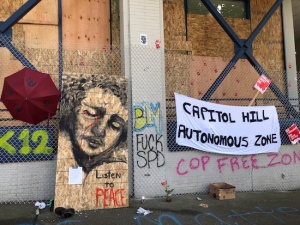
The author of this article studied Marxist-Leninist philosophy in the 1980s at Lomonosov University, Moscow. Between the time of writing and publication, the Seattle Commune has become known as Capitol Hill Autonomous Zone (CHAZ). Boxer added graphics and footnotes, with minor edits for punctuation.
Introduction
War, as Lenin described it, is the inevitable continuation of class struggle (1). Having witnessed the establishment of what I can only describe as The Seattle Commune (2), I have some remarks that might be helpful, in light of experience, both for observers and for participants.
The Seattle Commune
The Seattle Commune is presently a fluid area in the Capitol Hill district of Seattle, roughly centered around the baseball diamond in Cal Anderson Park. At present, the liberated area includes all of pine street from 11th and 12th avenues, and surrounding blocks. The commune was declared after the Washington Army National Guard covered the evacuation of the East Precinct of the Seattle Police Department, from their headquarters at 1519 12th Avenue, on the evening of 08 June 2020.

Tactics and Strategy
Theorists note that a partisan struggle has three distinct phases (3). In the first, the guerrillas use their superior mobility to fight hit-and-run battles with an entrenched and well-provisioned enemy. Eventually, a state of equilibrium is established in which popular support strengthens the guerrilla band and weakens the material conditions through which the status-quo has erupted. In the final stage, the guerrillas may begin overrunning positions held by the state, conquering and administering territory, and mopping up with large-scale encounters (4).
Che Guevara illustrates the obvious present problem with the Seattle Commune: The guerrilla struggle is currently just beginning, and already the guerrillas have announced that they are conquering territory. Guerrilla forces jumped directly to stage three, without ever accomplishing stages one or two. The guerrillas are presently congratulating themselves on social media, even as they “declare victory” for their cause, as their few sympathizers cheer them on and taunt their enemies. This is an illustration of just how politically savvy they aren’t.

Deconstruction
The present situation can be easily explained from the point of view of the established authorities. In hindsight, a materialist interpretation would include state actors allowing for the occupation of territory by guerrillas, knowing that the enemy is too weak and ill-informed to properly manage the administration of the same.
What is proper administration? When a guerrilla army conquers territory, it has a twofold responsibility. It first has to improve the material conditions of the inhabitants, and it simultaneously needs to defend the territory from invasion.
Can the rioters improve the lives of the residents under their control? Will they be able to afford the people in the captured territory a better life than the City of Seattle, in the United States of America? The answer to this question is obvious.
Supposing that the Seattle Commune was not a transparent trap that a bunch of college kids foolishly fell for. How would things progress? The first thing that a competent guerrilla commander would do is issue an invitation of all the residents of the fallen area to meet and discuss their concerns with him. During the meeting, a local soviet would be established (5), giving the residents — the people who actually live there — democratic control over the material conditions of their area. Strict military discipline would be handled by guerrilla commander, and any misbehavior by armed forces under his command would be rapidly punished (communist guerrilla commanders usually shoot thieves and rapists who take advantage of their position in an occupied town.) Aside from acting as police, the responsibility for providing food, medical supplies, power, and education falls immediately to the guerrillas, who transition from a band of partisans into the established executive for the local soviet.
The only reasonable interpretation of present events is to accept that the withdrawal of local police from the east precinct headquarters was done tactically, in order to force the guerrillas into the role of administration. This will strengthen the Seattle city authorities in two ways. First, it illuminates just how incompetent the guerrillas actually are. Going forward, every mistake made in the Seattle Commune will be used by local politicians as a propaganda victory. Second, it punishes local residents (without whom the guerrillas could not have been operating for the last week) by forcing them to rely upon the incompetent rioters they’ve been feeding and sheltering.

Conclusion
I don’t know what the future holds for the Seattle Commune, but I predict that nothing good will come of it. Likely scenarios include the guerrillas being chased out of the area by weary residents, or perhaps factional fighting between different groups of occupiers. Such projects usually devolve into violence or tedium.
If I were the mayor of Seattle, I would be broadcasting the possibility of shutting down power and water to the occupied territory, along with a declaration of amnesty, for anyone who voluntarily surrendered their weapons. The children who are playing at revolution ought to accept the fact that they’re fighting graduates from the U.S. Army’s war college, and save their efforts for another day.
Works Consulted
- Lenin. War and Revolution, 1917.
- Submedia. Map of CHAZ, 2020.
- Mao Tse-Tung. On Guerrilla Warfare, 1937.
- Che Guevara. Guerrilla Warfare, 1963.
- Leon Trotsky. “On Party Development” in Political Tasks, 1904.